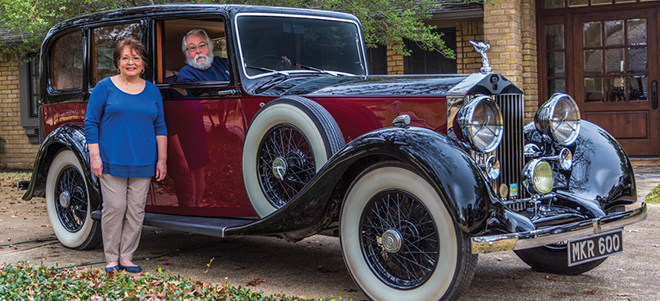
The company’s website describes the origin of its famous motorcar like this:
“With a shared ambition to make the future of motoring extraordinary, the Honourable Charles Rolls and Sir Henry Royce joined forces in 1904 and formed an unlikely partnership – one forged from a shared passion for engineering and a desire to create the Best Car in the World.”
When Bill and Lynne Downs acquired their 1937 Rolls-Royce Park Ward Wraith Touring Limousine in 2004, it was in good enough shape to capture the Al Kroemer Judges Choice Award and a first place class award at the Texas Region Rolls-Royce Owners Club (RROC) meet.
But during the event’s touring phase from Fort Worth to Granbury, with the car traveling at 55 miles per hour, the passenger side “suicide” door flew open, swept back in fury and pretty much destroyed the left side of the car.
“Save the door,” Bill declared from behind the wheel, to which his wife replied, “The door? What about saving me?!”

The next destination for the Rolls was Hand’s Elderly Auto Care shop in Grand Prairie, where Robert Hand set out not only to repair the damage, but ultimately to complete a full ground-up restoration of the magnificent pre-war classic. It would be eight years before all the meticulous work was finished, and the couple could take it back on the road to show it off in competition with others among the era’s finest vehicles.
In its first year back in the circuit, the car captured two top awards at the Rolls-Royce National Meet and next won the Best in Class Trophy at the annual Concours d’Elegance of Texas.

In 2014, the Downs’ car added another Best in Class award at the 63rd RROC annual competition and went on to pick up two more trophies last year at the organization’s most recent national event.
A special feature of their Rolls
is the Disappearing Division – a window partition that is hidden in the roof until the back seat passenger winds it down to provide some separation and privacy from the car’s chauffeur.
Due to the significant cost of adding this feature to the already very expensive automobile, the company equipped only 28 of the vehicles like the Downs’ car with this rare extra option.

Other models came with various versions of a separating panel, but the kind that disappeared into the roof when not in use consisted of 98 major parts engineered by a mechanical genius.
There are all kinds of other features on these exclusive vehicles, both among its mechanical workings and luxury appointments. But the hood ornament might be the most famous and, some would say, notorious of them all. With the development of radiator sculptures for automobiles around 1910, the managing director of Rolls-Royce commissioned sculptor Charles Sykes to create the Spirit of Ecstasy – “a mascot to convey speed with silence, absence of vibration, the mysterious harnessing of great energy and a living organism of superb grace.”
Stories abound of its origins
resulting from a secret passion between Baron Montagu, a pioneer of the automobile movement, and his secretary. The original design of the figurine was said to be of her in fluttering robes, having placed one forefinger against her lips to symbolize the secret of their love affair.

Only a few of those were ever made, and from 1920 until now, the current version has become the iconic symbol recognized all over the world. It remains the most stolen item off the famous cars, and the newest models include a button on the instrument panel to conceal it inside a closed compartment.
While many would assume one of these classics would be enough for anyone, Bill and Lynne got a little anxious while waiting during those eight years their car was being restored. So, they acquired a 1935 lime green Rolls-Royce and sent it off to another shop in Kansas City.
It is still there being completed. It might take eight years, too, Bill said with a smile. “In the meantime,” he noted, “I’m looking at installing another suspended lift in my garage to make room for it when it does arrive.”
Not surprisingly, Bill said owning an automobile of this ilk is a privilege. “We are owners of these cars for a brief period of time,” he said, “but we are caretakers for posterity.”
Read more classic car profiles from Arlington Today…
















